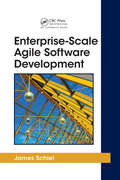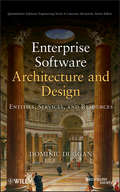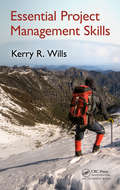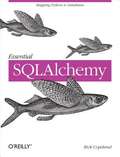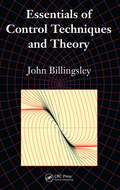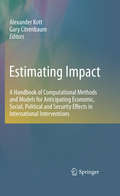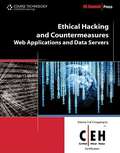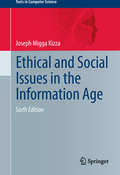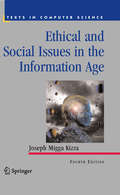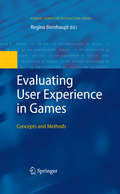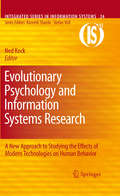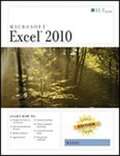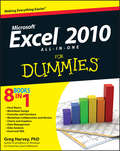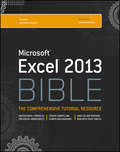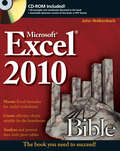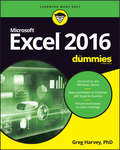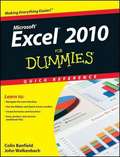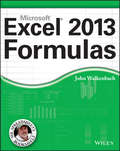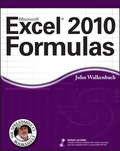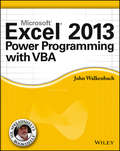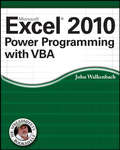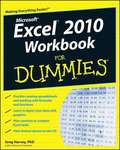- Table View
- List View
Enterprise JavaBeans 3.1: Developing Enterprise Java Components
by Bill Burke Andrew Lee RubingerLearn how to code, package, deploy, and test functional Enterprise JavaBeans with the latest edition of this bestselling guide. Written by the developers of JBoss EJB 3.1, this book not only brings you up to speed on each component type and container service in this implementation, it also provides a workbook with several hands-on examples to help you gain immediate experience with these components.With version 3.1, EJB's server-side component model for building distributed business applications is simpler than ever. But it's still a complex technology that requires study and lots of practice to master. Enterprise JavaBeans 3.1 is the most complete reference on this specification. You'll find a straightforward, no-nonsense explanation of the underlying technology, including Java classes and interfaces, the component model, and the runtime behavior of EJB.Develop your first EJBs with a hands-on walkthrough of EJB 3.1 conceptsLearn how to encapsulate business logic with Session Beans and Message-Driven BeansDiscover how to handle persistence through Entity Beans, the EntityManager, and the Java Persistence APIUnderstand EJB's container services such as dependency injection, concurrency, and interceptorsIntegrate EJB with other technologies in the Java Enterprise Edition platformUse examples with either the JBossAS, OpenEJB, or GlassFish v3 EJB Containers
Enterprise-Scale Agile Software Development (Applied Software Engineering Series)
by James SchielEnterprise-Scale Agile Software Development is the collective sum of knowledge accumulated during the full-scale transition of a 1400-person organization to agile development-considered the largest implementation of agile development and Scrum ever attempted anywhere in the world. Now James Schiel, a certified Scrum trainer and member of the Scrum
Enterprises software architecture and design
by Dominic DugganThis book fills a gap between high-level overview texts that are often too general and low-level detail oriented technical handbooks that lose sight the "big picture". This book discusses SOA from the low-level perspective of middleware, various XML-based technologies, and basic service design. It also examines broader implications of SOA, particularly where it intersects with business process management and process modeling. Concrete overviews will be provided of the methodologies in those fields, so that students will have a hands-on grasp of how they may be used in the context of SOA.
Environmental Communication. Second Edition: Skills and Principles for Natural Resource Managers, Scientists, and Engineers.
by Richard R. Jurin K. Jeffrey Danter Donny RoushEnvironmental professionals can no longer simply publish research in technical journals. Informing the public is now a critical part of the job. Environmental Communication demonstrates, step by step, how it's done, and is an essential guide for communicating complex information to groups not familiar with scientific material. It addresses the entire communications process, from message planning, audience analysis and media relations to public speaking - skills a good communicator must master for effective public dialogue. Environmental Communication provides all the knowledge and tools you need to reach your target audience in a persuasive and highly professional manner. "This book will certainly help produce the skills for environmental communications sorely needed for industry, government and non-profit groups as well as an informed public". Sol P. Baltimore, Director, Environmental Communications and Adjunct faculty, Hazardous Waste management program, Department of Chemical Engineering, College of Engineering, Wayne State University, Detroit, Michigan. "All environmental education professionals agree that the practice of good communications is essential for the success of any program. This book provides practical skills for this concern". Ju Chou, Associate Professor, Graduate Institute of Environmental Education National Taiwan Normal University Taipei, Taiwan
Essential Project Management Skills
by Kerry WillsIn today's business world, project managers not only have to be diligent in project planning and execution, but also need to have skills in persuasion, communication, and relationship management. Reflecting the changing landscape of projects today, Essential Project Management Skills empowers project managers to master the skills necessary to
Essential SQLAlchemy
by Rick CopelandEssential SQLAlchemy introduces a high-level open-source code library that makes it easier for Python programmers to access relational databases such as Oracle, DB2, MySQL, PostgreSQL, and SQLite. SQLAlchemy has become increasingly popular since its release, but it still lacks good offline documentation. This practical book fills the gap, and because a developer wrote it, you get an objective look at SQLAlchemy's tools rather than an advocate's description of all the "cool" features. SQLAlchemy includes both a database server-independent SQL expression language and an object-relational mapper (ORM) that lets you map "plain old Python objects" (POPOs) to database tables without substantially changing your existing Python code. Essential SQLAlchemy demonstrates how to use the library to create a simple database application, walks you through simple queries, and explains how to use SQLAlchemy to connect to multiple databases simultaneously with the same Metadata. You also learn how to:Create custom types to be used in your schema, and when it's useful to use custom rather than built-in types Run queries, updates, and deletes with SQLAlchemy's SQL expression language Build an object mapper with SQLAlchemy, and understand the differences between this and active record patterns used in other ORMs Create objects, save them to a session, and flush them to the database Use SQLAlchemy to model object oriented inheritance Provide a declarative, active record pattern for use with SQLAlchemy using the Elixir extension Use the SQLSoup extension to provide an automatic metadata and object model based on database reflection In addition, you'll learn how and when to use other extensions to SQLAlchemy, including AssociationProxy, OrderingList, and more.Essential SQLAlchemy is the much-needed guide for every Python developer using this code library. Instead of a feature-by-feature documentation, this book takes an "essentials" approach that gives you exactly what you need to become productive with SQLAlchemy right away.
Essentials of Control Techniques and Theory
by John BillingsleyCarefully separating the essential from the ornamental, Essentials of Control Techniques and Theory presents the nuts and bolts for designing a successful controller. It discusses the theory required to support the art of designing a working controller as well as the various aspects to convince a client, employer, or examiner of your expertise.A Compelling Account of the Basics of Control TheoryControl solutions for practicing engineersUsing the author’s own Javascript On-Line Learning Interactive Environment for Simulation (Jollies), the text relies on computer-based graphical analysis methods, such as Nyquist, Nichols, root locus, and phase-plane, to illustrate how useful computer simulation can be for analyzing both linear and nonlinear systems. It explains step-by-step the design and modeling of various control systems, including discrete time systems and an inverted pendulum. Along with offering many web-based simulations, the book shows how mathematics, such as vectors, matrices, and the differential equations that govern state variables, can help us understand the concepts that underpin the controller’s effects. From frequency domain analysis to time-domain state-space representation, this book covers many aspects of classical and modern control theory. It presents important methods for designing and analyzing linear systems and controllers.
Estimating Impact
by Alexander Kott Gary CitrenbaumVirtually all human endeavors can be analyzed and modeled and understood through computer-aided study, and that is very much at the core of operations research, game theory, and decision science. Understanding the potential impact of any action is critical to the success of that action, and in ESTIMATING IMPACT Alexander Kott and Gary Citrenbaum, with a stellar group of contributors, demonstrate how military or humanitarian interventions (or the decision not to intervene) can be rigorously analyzed beforehand and their likely impacts and ramifications predicted at levels appropriate to their scope. A wide range of modeling programs are available that support plan assessment and impact forecast, and they allow accurate prediction within an interdependent set of political, military, economic, social, information, and infrastructure systems, and experts involved in the use and development of these tools demonstrate how, when, and why they should be used.
Ethical Hacking and Countermeasures: Web Applications and Data Servers (Book #3)
by EC-Council StaffThe EC-Council - Press Ethical Hacking and Countermeasures series is intended for those studying to become security officers, auditors, security professionals, site administrators, and anyone who is concerned about or responsible for the integrity of the network infrastructure. The series includes a broad base of topics in offensive network security, ethical hacking, as well as network defense and countermeasures. Web Applications and Data Servers provides an overview of session hijacking, how to hack Web servers and database servers, as well as password-cracking techniques and Web application vulnerabilities.
Ethical and Social Issues in the Information Age
by Joseph Migga KizzaThe frequency of new editions of this book is indicative of the rapid and trem- dous changes in the fields of computer and information sciences. First published in 1995, the book has rapidly gone through three editions already and now we are in the fourth. Over this period, we have become more dependent on computer and telecommunication technology than ever before and computer technology has become ubiquitous. Since I started writing on social computing, I have been ad- cating a time when we, as individuals and as nations, will become totally dependent on computing technology. That time is almost on us. Evidence of this is embodied in the rapid convergence of telecommunication, broadcasting, and computing devices; the miniaturization of these devices; and the ever increasing storage capacity , speed of computation, and ease of use. These qualities have been a big pulling force sucking in millions of new users every day, sometimes even those unwilling. Other appealing features of these devices are the increasing number of applications, apps, as they are increasingly becoming known, and being wireless and easily portable. Whether small or big, these new gizmos have become the c- terpiece of an individual's social and economic activities and the main access point for all information. Individuals aside, computing technology has also become the engine that drives the nations' strategic and security infrastructures that control power grids, gas and oil storage facilities, transportation, and all forms of national communication, including emergency services.
Ethical and Social Issues in the Information Age, 4th Edition
by Joseph Migga KizzaThe frequency of new editions of this book is indicative of the rapid and tremendous changes in the fields of computer and information sciences. First published in 1995, the book has rapidly gone through three editions already and now we are in the fourth. Over this period, we have become more dependent on computer and telecommunication technology than ever before and computer technology has become ubiquitous. Since I started writing on social computing, I have been advocating a time when we, as individuals and as nations, will become totally dependent on computing technology. That time is almost on us. Evidence of this is embodied in the rapid convergence of telecommunication, broadcasting, and computing devices; the miniaturization of these devices; and the ever increasing storage capacity , speed of computation, and ease of use. These qualities have been a big pulling force sucking in millions of new users every day, sometimes even those unwilling. Other appealing features of these devices are the increasing number of applications, apps, as they are increasingly becoming known, and being wireless and easily portable. Whether small or big, these new gizmos have become the centerpiece of an individual’s social and economic activities and the main access point for all information. Individuals aside, computing technology has also become the engine that drives the nations’ strategic and security infrastructures that control power grids, gas and oil storage facilities, transportation, and all forms of national communication, including emergency services.
Evaluating User Experience in Games
by Regina BernhauptUser Experience has become a major research area in human-computer interaction. The area of game design and development has been focusing on user experience evaluation for the last 20 years, although a clear definition of user experience is still to be established. The contributors to this volume explore concepts that enhance the overall user experience in games such as fun, playability, flow, immersion and many others. Presenting an overview of current practice from academia and industry in game development, the book shows a variety of methods that can be used to evaluate user experience in games, not only during game-play but also before and after the game play. Evaluating User Experiences in Games: Presents a broad range of user experience evaluation methods and concepts; Provides insights on when to apply the various user experience evaluation methods in the development cycle and shows how methods can be also applied to a more general HCI context; Includes new research on evaluating user experience during game play and after; and social play; Describes new evaluation methods; Details methods that are also applicable for exertion games or tabletop games. This comprehensive book will be welcomed by researchers and practitioners in the field.
Evolutionary Psychology and Information Systems Research
by Ned KockThe point of Information System (IS) EP research then is that these evolved psychological traits very likely influence our behavior toward modern technologies, and a deeper understanding of how technology affects behavior might be achieved by applying concepts and theories from EP. Springer author Ned Kock (Information Systems Action Research: An Applied View of Emerging Concepts and Methods) is probably the leading scholar in IS-EP research, and he is proposing an AoIS volume to gather together for the first time invited papers on EP concepts and theories that can be used as a basis for future research; examples of ongoing IS-EP research; and a look at the current debate on IS-EP research. Kock will invite leading scholars in IS and IS-EP research as well as the leading scholars in pure EP (see attached proposal for all names) to contribute papers. Topics to be covered include basic human behavior toward technology; interface design; online dating and consumer behavior; information search and use behavior; and autopoiesis and self-organizing information systems.
Excel 2010 Basic Student Manual, First Look Edition
by Axzo PressExcel 2010 Basic Student Manual First Look Edition
Excel 2010 All-in-One For Dummies
by By Greg HarveyA comprehensive, up-to-date, user-friendly guide to Excel 2010 Excel is the standard for spreadsheet applications and is used worldwide, but it's not always user-friendly. That makes it a perfect For Dummies topic, and this handy all-in-one guide covers all the essentials, the new features, how to analyze data with Excel, and much more. Eight minibooks address Excel basics, worksheet design, formulas and functions, worksheet collaboration and review, charts and graphics, data management, data analysis, and Excel and VBA. Excel is the leading spreadsheet/data analysis software and is used throughout the world; the newest revision includes upgraded tools and a redesigned interface For Dummies books are the bestselling guides to Excel, with more than three million copies sold Excel 2010 All-in-One For Dummies covers the changes in the newest version as well as familiar tasks, such as creating and editing worksheets, setting up formulas, and performing statistical functions Eight self-contained minibooks cover the basics, worksheet design, formulas and functions, worksheet collaboration, presenting data in charts and graphics, data management, data analysis, and creating macros with VBA. Newcomers to Excel as well as veterans who just want to learn the latest version will find Excel 2010 All-in-One For Dummies has everything they need to know.
Excel 2010 Bible
by John WalkenbachA comprehensive reference to the newest version of the world's most popular spreadsheet application: Excel 2010 John Walkenbach's name is synonymous with excellence in computer books that decipher complex technical topics. Known as "Mr. Spreadsheet," Walkenbach shows you how to maximize the power of all the new features of Excel 2010. An authoritative reference, this perennial bestseller proves itself indispensable no matter your level of skill, from Excel beginners and intermediate users to power users and potential power users everywhere. Fully updated for the new release, this latest edition provides comprehensive, soup-to-nuts coverage, delivering over 900 pages of Excel tips, tricks, and techniques you won't find anywhere else. Excel guru and bestselling author John Walkenbach ("Mr. Spreadsheet") guides you through every aspect of Excel Delivers essential coverage of all the newest features of Excel 2010 Presents material in a clear, concise, logical format that is ideal for all levels of Excel experience Includes a CD that contains all the templates and worksheets used in the book plus John Walkenbach's award-winning Power Utility Pak Excel 2010 Bible serves as an excellent resource on all things Excel! Note: CD-ROM/DVD and other supplementary materials are not included as part of eBook file.
Excel 2010 Bible: Excel 2010 Bible, Access 2010 Bible, Powerpoint 2010 Bible, Word 2010 Bible (Bible #593)
by John WalkenbachA comprehensive reference to the newest version of the world’s most popular spreadsheet application: Excel 2010 John Walkenbach's name is synonymous with excellence in computer books that decipher complex technical topics. Known as "Mr. Spreadsheet," Walkenbach shows you how to maximize the power of all the new features of Excel 2010. An authoritative reference, this perennial bestseller proves itself indispensable no matter your level of skill, from Excel beginners and intermediate users to power users and potential power users everywhere. Fully updated for the new release, this latest edition provides comprehensive, soup-to-nuts coverage, delivering over 900 pages of Excel tips, tricks, and techniques you won’t find anywhere else. Excel guru and bestselling author John Walkenbach ("Mr. Spreadsheet") guides you through every aspect of Excel Delivers essential coverage of all the newest features of Excel 2010 Presents material in a clear, concise, logical format that is ideal for all levels of Excel experience Includes a CD that contains all the templates and worksheets used in the book plus John Walkenbach's award-winning Power Utility Pak Excel 2010 Bible serves as an excellent resource on all things Excel! Note: CD-ROM/DVD and other supplementary materials are not included as part of eBook file.
Excel 2010 For Dummies
by Greg HarveyThe bestselling Excel book on the market, updated for Excel 2010 As the world's leading spreadsheet application, Excel has a huge user base. The release of Office 2010 brings major changes to Excel, so Excel For Dummies comes to the rescue once more! In the friendly and non-threatening For Dummies style, this popular guide shows beginners how to get up and running with Excel and helps more experienced users get comfortable with new features. Excel is the number one spreadsheet application worldwide, and Excel For Dummies is the number one guide to using it With the major changes in Microsoft Office 2010, Excel has new features and a new interface design; users need help to get up to speed The book includes everything you need to know to perform basic Excel 2010 tasks Covers creating and editing worksheets and charts, formatting cells, entering formulas, inserting graphs, designing database forms, and adding database records Also covers printing, adding hyperlinks to worksheets, saving worksheets as Web pages, adding existing worksheet data to an existing Web page, and much more Whether you're new to Excel or just need to understand the 2010 version, Excel 2010 For Dummies provides what you need to know.
Excel 2010 For Dummies Quick Reference
by John Walkenbach Colin BanfieldFind the answers to your most important Excel questions with this referenceJohn Walkenbach's name is synonymous with excellence in computer books that decipher complex technical topics. Known as "Mr. Spreadsheet," Walkenbach--along with Excel expert Colin Banfield--answers your most common and important Excel questions in this easy-to-understand reference.You'll learn how to open, save, protect, and recover workbook files; add, copy, and delete worksheets; enter and edit data and text; create formulas and functions; audit, format, and print; and more. Highly organized and free of unnecessary jargon, this essential reference allows you to find the answers you're looking for quickly and easily.Excel gurus Walkenbach and Banfield offer quick and easy answers to common Excel questionsOffers information in a highly organized, easy-to-understand format so you can find exactly what you needIncludes information on opening, saving, protecting and recovering workbook files; adding, copying, and deleting worksheets; entering and editing data and text; creating formulas and functions; auditing; formatting; printing; and moreCovers navigating the user interface; using the Ribbon and Quick Access toolbar; saving, protecting, and recovering workbook files; entering and editing data; creating formulas and functions, and much moreExcel 2010 For Dummies Quick Reference enables you to spend more time working on your projects rather than trying to figure how to make Excel work for you!
Excel 2010 Formulas
by John WalkenbachTake your Excel formulas to the next level with this updated reference John Walkenbach's name is synonymous with excellence in computer books that decipher complex technical topics. Known as "Mr. Spreadsheet," Walkenbach provides you with clear explanations on all the methods you can use to maximize the power of Excel with formulas within the frameworks of all the new features of Excel 2010. You'll learn how to create financial formulas, maximize the power of array formulas, develop custom worksheet functions with VBA, debug formulas, and much more. This invaluable reference is fully updated for the new Microsoft Office release and provides comprehensive formulas coverage, delivering more than 800 pages of Excel tips, tricks, and techniques you won't find anywhere else. Demonstrates how to use all the new features of Excel 2010 to maximize your formulas Shows how to develop custom worksheet functions with VBA, debug formulas, create financial formulas, and more Serves as an indispensable reference no matter your skill level Includes a valuable CD-ROM with sample files, templates and worksheets from the book, plus John Walkenbach's award-winning Power Utility Pak Prepare to excel with Excel when you have John Walkenbach and Excel 2010 Formulas by your side! Note: CD-ROM/DVD and other supplementary materials are not included as part of eBook file.
Excel 2010 Formulas (Mr. Spreadsheet's Bookshelf #7)
by John WalkenbachTake your Excel formulas to the next level with this updated reference John Walkenbach's name is synonymous with excellence in computer books that decipher complex technical topics. Known as "Mr. Spreadsheet," Walkenbach provides you with clear explanations on all the methods you can use to maximize the power of Excel with formulas within the frameworks of all the new features of Excel 2010. You'll learn how to create financial formulas, maximize the power of array formulas, develop custom worksheet functions with VBA, debug formulas, and much more. This invaluable reference is fully updated for the new Microsoft Office release and provides comprehensive formulas coverage, delivering more than 800 pages of Excel tips, tricks, and techniques you won't find anywhere else. Demonstrates how to use all the new features of Excel 2010 to maximize your formulas Shows how to develop custom worksheet functions with VBA, debug formulas, create financial formulas, and more Serves as an indispensable reference no matter your skill level Includes a valuable CD-ROM with sample files, templates and worksheets from the book, plus John Walkenbach's award-winning Power Utility Pak Prepare to excel with Excel when you have John Walkenbach and Excel 2010 Formulas by your side! Note: CD-ROM/DVD and other supplementary materials are not included as part of eBook file.
Excel 2010 Just the Steps For Dummies
by Diane KoersPick your Excel task, find it fast, and get it done with Just the Steps! If you want to see how to do a particular Excel task, this is the perfect book. Each page includes step-by-step instruction in one column and illustrations and screenshots in the other column, so you have all the information you need in one place-no flipping pages! Improve your Excel skills with just the steps for entering spreadsheet data, building formulas, protecting excel data, formatting cells, designing spreadsheets with graphics, managing workbooks, changing worksheet values, sorting and filtering data, creating charts, creating PivotTables, building macros, integrating Excel into other Office programs, and-whew!-still more. Explains essentials tasks for Excel 2010, the spreadsheet application that is part of the Microsoft Office 2010 suite Shows you just the steps for numerous Excel tasks using an easy-to-follow, two-column page layout, with step-by-step instruction on one side and illustrations and screenshots on the other Covers entering spreadsheet data, building formulas, protecting excel data, formatting cells, designing spreadsheets with graphics, managing workbooks, changing worksheet values, sorting and filtering data, creating charts, creating PivotTables, and building macros Walks you step by step through collaborating in Excel and integrating or using Excel with Word, PowerPoint, and Access Make your tasks easier, improve your Excel skills, and get better results with this step-by-step guide.
Excel 2010 Power Programming with VBA
by John WalkenbachAll the methods and tools you need to successfully program with Excel John Walkenbach's name is synonymous with excellence in computer books that decipher complex technical topics. With this comprehensive guide, "Mr. Spreadsheet" shows you how to maximize your Excel experience using professional spreadsheet application development tips from his own personal bookshelf. Featuring a complete introduction to Visual Basic for Applications and fully updated for the new features of Excel 2010, this essential reference includes an analysis of Excel application development and is packed with procedures, tips, and ideas for expanding Excel's capabilities with VBA. Offers an analysis of Excel application development and a complete introduction to Visual Basic for Applications (VBA) Features invaluable advice from "Mr. Spreadsheet" himself (bestselling author John Walkenbach), who demonstrates all the techniques you need to create large and small Excel applications Provides tips, tricks, and techniques for expanding Excel's capabilities with VBA that you won't find anywhere else Includes a CD with templates and worksheets from the book This power-user's guide is packed with procedures, tips, and ideas for expanding Excel's capabilities with VBA. Note: CD-ROM/DVD and other supplementary materials are not included as part of eBook file.
Excel 2010 Power Programming with VBA (Mr. Spreadsheet's Bookshelf #6)
by John WalkenbachAll the methods and tools you need to successfully program with Excel John Walkenbach's name is synonymous with excellence in computer books that decipher complex technical topics. With this comprehensive guide, "Mr. Spreadsheet" shows you how to maximize your Excel experience using professional spreadsheet application development tips from his own personal bookshelf. Featuring a complete introduction to Visual Basic for Applications and fully updated for the new features of Excel 2010, this essential reference includes an analysis of Excel application development and is packed with procedures, tips, and ideas for expanding Excel’s capabilities with VBA. Offers an analysis of Excel application development and a complete introduction to Visual Basic for Applications (VBA) Features invaluable advice from "Mr. Spreadsheet" himself (bestselling author John Walkenbach), who demonstrates all the techniques you need to create large and small Excel applications Provides tips, tricks, and techniques for expanding Excel's capabilities with VBA that you won’t find anywhere else This power-user's guide is packed with procedures, tips, and ideas for expanding Excel's capabilities with VBA.
Excel 2010 Workbook For Dummies
by Greg HarveyReinforce your understanding of Excel with these Workbook exercises Boost your knowledge of important Excel tasks by putting your skills to work in real-world situations. The For Dummies Workbook format provides more than 100 exercises that help you create actual results with Excel so you can gain proficiency. Perfect for students, people learning Excel on their own, and financial professionals who must plan and execute complex projects in Excel, Excel 2010 Workbook For Dummies helps you discover all the ways this program can work for you. Excel is the world's most popular number-crunching program, and For Dummies books are the most popular guides to Excel The Workbook approach offers practical application, with more than 100 exercises to work through and plenty of step-by-step guidance This guide covers the new features of Excel 2010, includes a section on creating graphic displays of information, and offers ideas for financial planners Also provides exercises on using formulas and functions, managing and securing data, and performing data analysis A companion CD-ROM includes screen shots and practice materials Excel 2010 Workbook For Dummies helps you get comfortable with Excel so you can take advantage of all it has to offer. Note: CD-ROM/DVD and other supplementary materials are not included as part of eBook file.

